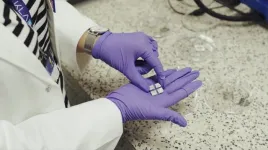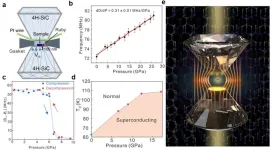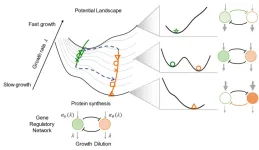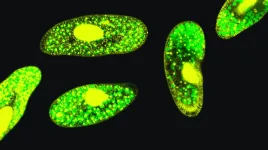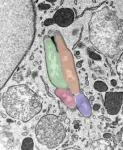(Press-News.org) Scientists from Swansea University ‘s Institute for Innovative Materials, Processing and Numerical Technologies (IMPACT) and Japan have been awarded £1.3 million to develop a new “point of care testing” kit that can detect biomarkers for Alzheimer's Disease.
The project follows Dr Sanjiv Sharma’s ground-breaking work in this area and the development of the world’s first COVID-19 ‘smart patch’.
Compared to hypodermic single needles, a ‘smart patch’ consists of a collection of tiny needles - microneedles - created to break the skin barrier in a minimally invasive manner, similar to a nicotine patch. Their innovative design means they can be developed to identify and monitor specific biomarkers in the skin.
This new major project will see Dr Sharma lead a consortium of leading scientists from Swansea University, Imperial College London and The University of Glasgow. Dr Kaori Tsukakoshi will steer researchers from Japan with Tokyo University of Agriculture & Technology and National Institutes for Quantum Science & Technology. Together they will create a Point-of-Care Testing Kit to facilitate early diagnosis and monitoring of disease progression in primary clinics or home settings.
Dr Sanjiv Sharma of Swansea University comments:
"Alzheimer’s Disease (AD) is the most prevalent form of dementia. It is presently untreatable and associated with a high social and familial burden, for which national health systems are not prepared, constituting a major challenge for sustainable development.
Over a million people in the UK are predicted to have dementia by 2025 and with the current cost of £26 billion a year to the UK economy, there is a huge financial and societal impact. Similarly, Japan’s aging population is witnessing an increase in AD. This increase of total prevalent AD cases in those ages 60 years and older from 3.5 million cases in 2016 to 4.9 million cases in 2026 corresponds to an annual growth rate of 4%. There are similar trends seen globally.
As disease modifying-treatments (DMT) for AD are becoming a possibility, evidence suggests any effective preventive or DMT must be started very early in the disease process, stressing the importance of an early diagnosis based on easily accessible biomarkers. Thus, the development of non-invasive markers of AD pathology in blood and skin samples is essential for screening the elderly population with memory complaints and could represent the first step to determine individuals at greatest risk of AD dementia."
Dr Kaori Tsukakoshi of Tokyo University of Agriculture and Technology comments:
“In the last decade, blood biomarkers for AD diagnosis have been extensively studied and are finally being established. Our collaborative research focusing on the development of the Point-of-Care Testing device for the AD biomarkers would facilitate a new diagnostic process of AD, which will enable more patients with AD to be led to upcoming DMT for AD.”
This is a multidisciplinary research project co-funded by the Medical Research Council – UK Research and Innovation, and the Japan Agency for Medical Research and Development (AMED).
The IMPACT operation is part-funded by the European Regional Development Fund through the Welsh Government and Swansea University
END
Notes to editors:
Swansea University is a world-class, research-led, dual campus university offering a first-class student experience and has one of the best employability rates of graduates in the UK. The University has the highest possible rating for teaching – the Gold rating in the Teaching Excellence Framework (TEF) in 2018 and was commended for its high proportions of students achieving consistently outstanding outcomes.
Swansea climbed 14 places to 31st in the Guardian University Guide 2019, making us Wales’ top ranked university, with one of the best success rates of graduates gaining employment in the UK and the same overall satisfaction level as the Number 1 ranked university.
The 2014 Research Excellence Framework (REF) 2014 results saw Swansea make the ‘biggest leap among research-intensive institutions’ in the UK (Times Higher Education, December 2014) and achieved its ambition to be a top 30 research University, soaring up the league table to 26th in the UK.
The University is in the top 300 best universities in the world, ranked in the 251-300 group in The Times Higher Education World University rankings 2018. Swansea University now has 23 main partners, awarding joint degrees and post-graduate qualifications.
The University was established in 1920 and was the first campus university in the UK. It currently offers around 350 undergraduate courses and 350 postgraduate courses to circa 20,000 undergraduate and postgraduate students. The University has ambitious expansion plans as it moves towards its centenary in 2020 and aims to continue to extend its global reach and realise its domestic and international potential.
Swansea University is a registered charity. No.1138342. Visit www.swansea.ac.uk
For more information:
Kevin Sullivan, senior press officer, Swansea University k.g.sullivan@swansea.ac.uk
Follow us on Twitter: www.twitter.com/SwanseaUni
Find us on Facebook: www.facebook.com/swanseauniversity
END
Alzheimer's early detection through biomarkers -
award for Swansea University and Tokyo University project
2023-03-23
ELSE PRESS RELEASES FROM THIS DATE:
Rates of autism climb to new highs in the U.S., with California setting record numbers
2023-03-23
New federal studies coauthored by autism experts at Rutgers found that more children have been diagnosed with autism than at any time since monitoring began more than two decades ago.
According to the U.S. Centers for Disease Control and Prevention (CDC), about 4 percent of 8-year-old boys and 1 percent of 8-year-old girls, have autism in the U.S. These estimates are the highest since the CDC’s Autism and Developmental Disabilities Monitoring (ADDM) Network was created in 2000.
Biennial studies from the ADDM Network, which analyzed ...
Study uncovers aspect of how muscular dystrophies progress
2023-03-23
A research study has shed new light on how congenital muscular dystrophies such as Walker-Warburg syndrome progress, bringing hope for better understanding, early diagnosis and treatments of these fatal disorders.
Published in March in the Journal of Biological Chemistry, the research was led by scientists in the lab of Vlad Panin, Ph.D., professor in the Department of Biochemistry and Biophysics in the Texas A&M College of Agriculture and Life Sciences. The study is titled “Protein tyrosine phosphatase 69D is a substrate of protein O-mannosyltransferases 1-2 that is required for the wiring of sensory axons in Drosophila.” ...
Researchers make breakthrough in high-pressure magnetic detection
2023-03-23
According to a study published in Nature Materials, a collaborative research team from the Hefei Institutes of Physical Science of the Chinese Academy of Sciences (CAS) and the University of Science and Technology of China has developed a research platform to study superconducting magnetic detection and magnetic phase transitions of hydrides under high pressure.
High-resolution in-situ magnetic measurement under high pressure has been a challenge. It has limited the progress of research on the Meissner effect of superconductivity and on magnetic phase transition behavior under high pressure. Using the optically detected ...
Cellular growth rate reshapes cell-fate-decision landscape
2023-03-23
Genes and the regulation relationships among them create complex networks that determine cell differentiation trajectories. However, we still cannot understand and predict the cell-fate-decision process using network topology in a bottom-up manner.
Recently, a research group led by Prof. FU Xiongfei from the Shenzhen Institute of Advanced Technology (SIAT) of the Chinese Academy of Sciences (CAS) has revealed how the global regulation factor, cellular growth rate, reshapes the cell-fate-decision landscape.
The ...
Where does your brain want to have lunch?
2023-03-23
New research published by investigators at Cedars-Sinai advances scientific understanding of how the brain weighs decisions involving what people like or value, such as choosing which book to read, which restaurant to pick for lunch—or even, which slot machine to play in a casino. Published today in the peer-reviewed journal Nature Human Behaviour, this study involved recording the activity of individual human neurons.
The study examined decisions called value-based choices, where there is ...
Microplastics limit energy production in tiny freshwater species
2023-03-23
Microplastic pollution reduces energy production in a microscopic creature found in freshwater worldwide, new research shows.
Paramecium bursaria contain algae that live inside their cells and provide energy by photosynthesis.
The new study, by the University of Exeter, tested whether severe microplastic contamination in the water affected this symbiotic relationship.
The results showed a 50% decline in net photosynthesis – a major impact on the algae’s ability to produce energy and release ...
SwRI, JPL study suggests explanation for unusual radar signatures of icy satellites in the outer solar system
2023-03-23
SAN ANTONIO — March 23, 2023 —A study co-authored by Southwest Research Institute Senior Research Scientist Dr. Jason Hofgartner explains the unusual radar signatures of icy satellites orbiting Jupiter and Saturn. Their radar signatures, which differ significantly from those of rocky worlds and most ice on Earth, have long been a vexing question for the scientific community.
“Six different models have been published in an attempt to explain the radar signatures of the icy moons that orbit Jupiter and Saturn,” said Hofgartner, first author of the study, ...
Harnessing power of immune system may lessen reliance on antibiotics for infections like TB
2023-03-23
Francis Crick Institute press release
Under strict embargo: 16:00 GMT 23 March 2023
Peer reviewed
Experimental study
Human stem cells
Researchers at the Francis Crick Institute have found that the body’s process of removing old and damaged cell parts, is also an essential part of tackling infections that take hold within our cells, like TB.
If this natural process can be harnessed with new treatments, it could present an alternative to, or improve use of antibiotics, especially where bacteria have become ...
Newly discovered cell in fruit flies is essential for touch sensation
2023-03-23
The Francis Crick Institute press release
Under strict embargo: 16:00 GMT Thursday 23rd March
Peer reviewed
Experimental
Cells
Researchers at the Francis Crick Institute have uncovered a key role for a new type of cell in touch detection in the skin of the fruit fly.
Touch allows animals to navigate their environment by gathering information from the outside world. In their study published today in Nature Cell Biology, Dr Federica Mangione and Dr Nicolas Tapon shed light on how touch-sensitive organs assemble during development.
In particular the team studied the development ...
Researchers discover a way to fight the aging process and cancer development
2023-03-23
A protein complex prevents the repair of genome damage in human cells, in mice and in the nematode Caenorhabditis elegans, a team of researchers at the University of Cologne has discovered. They also successfully inhibited this complex for the first time using a pharmaceutical agent.
“When we suppress the so-called DREAM complex in body cells, various repair mechanisms kick in, making these cells extremely resilient towards all kinds of DNA damage,” said Professor Dr Björn Schumacher, Director of the Institute for Genome Stability in Aging ...
LAST 30 PRESS RELEASES:
ASH 2025: AI uncovers how DNA architecture failures trigger blood cancer
ASH 2025: New study shows that patients can safely receive stem cell transplants from mismatched, unrelated donors
Protective regimen allows successful stem cell transplant even without close genetic match between donor and recipient
Continuous and fixed-duration treatments result in similar outcomes for CLL
Measurable residual disease shows strong potential as an early indicator of survival in patients with acute myeloid leukemia
Chemotherapy and radiation are comparable as pre-transplant conditioning for patients with b-acute lymphoblastic leukemia who have no measurable residual disease
Roughly one-third of families with children being treated for leukemia struggle to pay living expenses
Quality improvement project results in increased screening and treatment for iron deficiency in pregnancy
IV iron improves survival, increases hemoglobin in hospitalized patients with iron-deficiency anemia and an acute infection
Black patients with acute myeloid leukemia are younger at diagnosis and experience poorer survival outcomes than White patients
Emergency departments fall short on delivering timely treatment for sickle cell pain
Study shows no clear evidence of harm from hydroxyurea use during pregnancy
Long-term outlook is positive for most after hematopoietic cell transplant for sickle cell disease
Study offers real-world data on commercial implementation of gene therapies for sickle cell disease and beta thalassemia
Early results suggest exa-cel gene therapy works well in children
NTIDE: Disability employment holds steady after data hiatus
Social lives of viruses affect antiviral resistance
Dose of psilocybin, dash of rabies point to treatment for depression
Helping health care providers navigate social, political, and legal barriers to patient care
Barrow Neurological Institute, University of Calgary study urges “major change” to migraine treatment in Emergency Departments
Using smartphones to improve disaster search and rescue
Robust new photocatalyst paves the way for cleaner hydrogen peroxide production and greener chemical manufacturing
Ultrafast material captures toxic PFAS at record speed and capacity
Plant phenolic acids supercharge old antibiotics against multidrug resistant E. coli
UNC-Chapel Hill study shows AI can dramatically speed up digitizing natural history collections
OYE Therapeutics closes $5M convertible note round, advancing toward clinical development
Membrane ‘neighborhood’ helps transporter protein regulate cell signaling
Naval aviator turned NPS doctoral student earns national recognition for applied quantum research
Astronomers watch stars explode in real time through new images
Carbon-negative building material developed at Worcester Polytechnic Institute published in matter
[Press-News.org] Alzheimer's early detection through biomarkers -award for Swansea University and Tokyo University project
